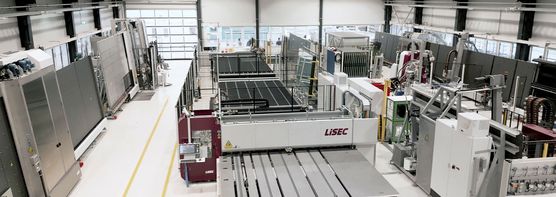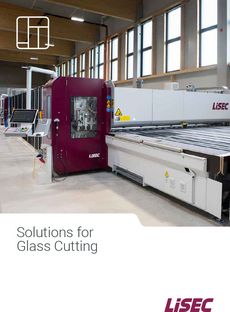
Systems & Lines
Glass Cutting Line for Laminated Glass
- LiSEC
- Systems & Lines
- Glass Cutting Line for Laminated Glass
- Laminated glass cutting system solution
Laminated glass cutting system solution
High capacity and quality for automatic laminated glass cutting - XYZ 75-140 pcs/h
State-of-the-art laminated glass cutting system with two cutting bridges and dynamic load control for continuous and high cutting performance with simultaneous maximum edge quality and efficiency with respect to wastage and operating cost reduction.
How is the line for laminated glass cutting constructed?
The laminated glass cutting system solution from LiSEC is composed of an infeed-side system for automatic removal of the film overhang (FASV), as well as a Lucite scraper brush, a system for removing the surface coating (DSC-A, ESL-RS,), and up to two laminated glass cutting bridges (VSL-A) positioned one behind the other. The automatic removal of the film overhang enhances cutting accuracy, improves process reliability throughout production, reduces the need for operator intervention and allows the raw glass to be processed without any trim cutting, which reduces glass consumption and consequently operating costs.
The system solution can be equipped with or without an edge deletion unit, for the removal of thermal insulation coatings as well as solar protection coatings. An efficient, fast and residue-free technology by means of a grinding wheel is used. A transport section following the edge deletion system acts as a buffer and thereby decouples the edge deletion process from the first laminated glass cutting bridge.
The first VSL-A cutting bridge from LiSEC cuts the front trim cut up to a minimum of 20 mm, cuts the X-sub plates of the cutting optimisation, automatically rotates the X-sub plates by 90° and removes the Y-residue on the trailing edge. Belt transport fields feed these prepared and rotated sub-plates to the second laminated glass cutting bridge, which cuts, breaks and separates the Y-, Z-cuts from the PVB-foil quickly and fully automatically with minimal wastage. The finished cut sheets are then either removed manually by a system operator or fed to a downstream automatic sorting system, fan carriage loading unit or robot removal unit. This ensures almost unmanned processing of laminated glass. The benefits of cutting approx. 75 - 140 pieces with approx. 6 % less wastage and up to approx. 10 % higher edge quality constitute the basis of this system solution for the automatic cutting of laminated glass. The reduced need for qualified personnel and the high level of work safety, system availability and simple operation are additional guarantees for efficiency.
What are the special aspects of this laminated glass cutting system solution?
The laminated glass cutting solution with two VSL-A systems is manufactured using the latest and most modern components from LiSEC. The heart of this solution for laminated glass cutting lies in dynamic load balancing (DLB). The dynamic load balancing (DLB) collects and processes data in real time from the entire system. The production volume is automatically distributed to the two laminated glass cutting bridges based on this in order to ensure ideal load utilisation for the respective cutting optimisation. This can reduce the throughput time and increase the cutting output per hour.
What additional benefits does this line offer?
When developing this laminated glass cutting solution, LiSEC placed special emphasis on a space-saving and compact design. The arrangement of the laminated glass cutting bridges in a row allows this production line to be arranged in parallel to a float glass cutting line and both lines to be supplied with a compact glass storage – and all this with minimal space requirements in the production hall. This laminated glass cutting from LiSEC with VSL-A technology represents an ideal expansion of production capacities, especially for insulating glass manufacturers who need to respond to the rapidly increasing demand for laminated glass, while at the same time reducing operating costs by saving on wastage and personnel.
For whom is this cutting system suitable?
This system is intended for both medium-sized businesses and large industrial operations. Depending on the design, a cutting capacity of approx. 75 – 140 pieces of ready-cut laminated glass sheets per hour can be calculated. The optimal solution for small businesses is to start with a VSL-A type laminated glass cutting bridge. It is possible to add a second laminated glass cutting bridge – and therefore upgrade to a laminated glass cutting system solution with dynamic load balancing (DLB) – at any time.
Why is this solution so interesting, especially when it comes to the shortest cycle times?
LiSEC is offering a patented and unique option on the market, especially for highly automated insulating glass processing companies with particularly short throughput times and two- and three-shift production. The optional "Tandem cutting" version can be used to run the second laminated glass cutting bridge for cutting up to two sub-plates at the same time. Especially for series production with a multitude of identical sheets. The simultaneous cutting makes it possible to cut up to approx. 140 pieces of laminated glass fully automatically and virtually without manpower.
Standard functions
- Fully automatic 20 mm cutting, breaking and separating possible on all four sides of the raw dimension
- Glass thickness 22.1 (4.38 mm) to 1010.12 (24.56 mm) as standard
- Laminated glass cutting of X, Y and Z sub-plates
- Automatic sub-plate turning up to 2,200 mm sheet length
- Version with patented Selective Infrared Heating (SIR) for especially fast and protective heating of the PVB-foil (4 s heating time with 44.1 laminated glass)
- Automatic off-cut disposal of up to 300 mm in a container for broken glass
- Innovative operating concept with comfort and sport modes for ideal adaptation to the day's production
- Extra high level of work safety thanks to permanent monitoring of the work surface with laser scanner for maximum system safety
- Version with dynamic load balancing (DLB) for up to 75 cut sheets per hour
Options & Software
- Version with 3.7 m, 4.7 m or 6.1 m as second cutting bridge
- Version for glass thicknesses up to 1212.12 (28.56 mm)
- Version with automatic turning function up to the maximum dimension (depending on the second cutting bridge)
- Version with automatic shredding and disposal system for laminated glass residues (GSA-CL) for even higher system availability and less off-cut glass handling
- Version with additional cutting head top/bottom for automatic cutting wheel change, for reduction of operator intervention
- Tandem cutting possible on the second cutting bridge, meaning simultaneous cutting of two Y- and Z-cuts for up to 140 finished sheets per hour
Additional options
- Automatic special shape cutting for laminated glass
- Automatic processing of float glass and film-coated glass as well as automatic breaking of the X sub-plates via breaker bar
- Tilt arms to unload large glass sheets easily
- Automatic rotating function for finished cut sheets for automatic connection to a downstream sorting system
- Fast and flexible cutting of laminated glass, up to approx. 75 – 140 pieces per hour
- Flexible and efficient thanks to dynamic load balancing (DLB)
- Up to 10 % higher edge quality and accuracy with shortest cutting time
The Highlights
Fast and flexible cutting of laminated glass, up to approx. 75 – 140 pieces per hour
Using a VSL-A system solution with two cutting bridges extended with dynamic load balancing (DLB) allows the VSL-A Tandem to provide continuous high output and process reliability under any conditions. Depending on the version (with or without the Tandem option) and optimisation (cutting plan), this allows up to approx. 140 completed sheets per hour.

Flexible and efficient thanks to dynamic load balancing (DLB)
This intelligent software solution ensures that both cutting bridges are ideally utilised, based on the respective cutting optimisation. The laminated glass is cut, broken and separated entirely automatically. Rotation and further feed requires no operator intervention. Complete cut laminated glass is consistently delivered. Laminated glass just in time — the result is cutting independent of operator and environmental influences. The comfort and sport modes mean that the system can be easily switched according to the required production capacity in order to cope with production peaks.

Up to 10 % higher edge quality and accuracy with shortest cutting time
The Selective Infrared Heating (SIR) with 900 mm high-performance foil heating, specially developed to meet current and future requirements of laminated glass cutting, reduces heat stress at the cutting edge and ensures up to approx. 10 % higher edge strength. Double precision-guided cutting heads with direct drive and dynamic cutting pressure control, including cutting wheel consumption monitoring, reducing oblique breaks and splintering, and forming the basis for successful cutting of laminated glass without scratches. Grind additions can also be significantly reduced – which is reflected in the reduced edge processing costs.

- Systems & Lines
- Individual Machines
- Software
















